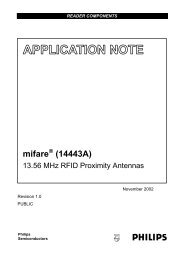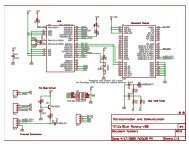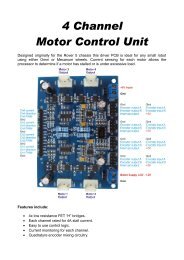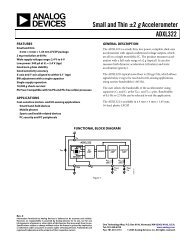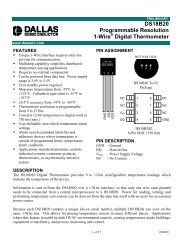u-blox 6
u-blox 6
u-blox 6
Create successful ePaper yourself
Turn your PDF publications into a flip-book with our unique Google optimized e-Paper software.
5 Receiver Configuration<br />
5.1 Configuration Concept<br />
u-<strong>blox</strong> positioning technology is fully configurable with UBX protocol configuration messages (message class<br />
UBX-CFG). The configuration used by the GPS receiver during normal operation is termed "Current<br />
Configuration". The Current Configuration can be changed during normal operation by sending any<br />
UBX-CFG-XXX message to the receiver over an I/O port. The receiver will change its Current Configuration<br />
immediately after receiving the configuration message. The GPS receiver always uses only the Current<br />
Configuration.<br />
Unless the Current Configuration is made permanent by using CFG-CFG as described below, the Current<br />
Configuration will be lost in case of (see message CFG-RST)<br />
• a power cycle<br />
• a hardware reset<br />
• a (complete) controlled software reset<br />
The Current Configuration can be made permanent (stored in a non-volatile memory) by saving it to the<br />
"Permanent Configuration". This is done by sending a UBX-CFG-CFG message with an appropriate saveMask<br />
(UBX-CFG-CFG/save).<br />
The Permanent Configurations are copied to the Current Configuration after start-up or when a UBX-CFG-CFG<br />
message with an appropriate loadMask (UBX-CFG-CFG/load) is sent to the receiver.<br />
The Permanent Configuration can be restored to the receiver's Default Configuration by sending a<br />
UBX-CFG-CFG message with an appropriate clearMask (UBX-CFG-CFG/clear) to the receiver.<br />
This only replaces the Permanent Configuration, not the Current Configuration. To make the receiver operate<br />
with the Default Configuration which was restored to the Permanent Configuration, a UBX-CFG-CFG/load<br />
command must be sent or the receiver must be reset.<br />
The mentioned masks (saveMask, loadMask, clearMask) are 4-byte bitfields. Every bit represents one<br />
configuration sub-section. These sub-sections are defined in section "Organization of the Configuration<br />
Sections"). All three masks are part of every UBX-CFG-CFG message. Save, load and clear commands can be<br />
combined in the same message. Order of execution is clear, save, load.<br />
The following diagram illustrates the process:<br />
GPS.G6-SW-10018-A Public Release Page 14 of 201



